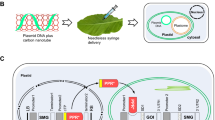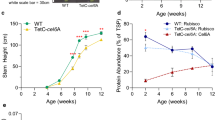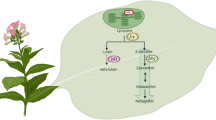Abstract
Key message
By using the organelle glue technique, we artificially manipulated organelle interactions and controlled the plant metabolome at the pathway level.
Abstract
Plant cell metabolic activity changes with fluctuating environmental conditions, in part via adjustments in the arrangement and interaction of organelles. This hints at the potential for designing plants with desirable metabolic activities for food and pharmaceutical industries by artificially controlling the interaction of organelles through genetic modification. We previously developed a method called the organelle glue technique, in which chloroplast–chloroplast adhesion is induced in plant cells using the multimerization properties of split fluorescent proteins. Here, we generated transgenic Arabidopsis (Arabidopsis thaliana) plants in which chloroplasts adhere to each other and performed metabolome analysis to examine the metabolic changes in these lines. In plant cells expressing a construct encoding the red fluorescent protein mCherry targeted to the chloroplast outer envelope by fusion with a signal sequence (cTP-mCherry), chloroplasts adhered to each other and formed chloroplast aggregations. Mitochondria and peroxisomes were embedded in the aggregates, suggesting that normal interactions between chloroplasts and these organelles were also affected. Metabolome analysis of the cTP-mCherry-expressing Arabidopsis shoots revealed significantly higher levels of glycine, serine, and glycerate compared to control plants. Notably, these are photorespiratory metabolites that are normally transported between chloroplasts, mitochondria, and peroxisomes. Together, our data indicate that chloroplast–chloroplast adhesion alters organellar interactions with mitochondria and peroxisomes and disrupts photorespiratory metabolite transport. These results highlight the possibility of controlling plant metabolism at the pathway level by manipulating organelle interactions.




Similar content being viewed by others
Data availability
All data in this study are available from the corresponding author upon reasonable request.
References
Cavanagh AP, South PF, Bernacchi CJ, Ort DR (2022) Alternative pathway to photorespiration protects growth and productivity at elevated temperatures in a model crop. Plant Biotechnol J 20:711–721. https://doi.org/10.1111/pbi.13750
Clough SJ, Bent AF (1998) Floral dip: a simplified method for Agrobacterium-mediated transformation of Arabidopsis thaliana. Plant J 16:735–743. https://doi.org/10.1046/j.1365-313x.1998.00343.x
Costantini LM, Fossati M, Francolini M, Snapp EL (2012) Assessing the tendency of fluorescent proteins to oligomerize under physiologic conditions. Traffic 13:643–649. https://doi.org/10.1111/j.1600-0854.2012.01336.x
Cranfill PJ, Sell BR, Baird MA et al (2016) Quantitative assessment of fluorescent proteins. Nat Methods 13:557–562. https://doi.org/10.1038/nmeth.3891
Cui L-L, Lu Y-S, Li Y et al (2016) Overexpression of glycolate oxidase confers improved photosynthesis under high light and high temperature in rice. Front Plant Sci 7:1165. https://doi.org/10.3389/fpls.2016.01165
Eisenhut M, Roell MS, Weber APM (2019) Mechanistic understanding of photorespiration paves the way to a new green revolution. New Phytol 223:1762–1769. https://doi.org/10.1111/nph.15872
Hagemann M, Bauwe H (2016) Photorespiration and the potential to improve photosynthesis. Curr Opin Chem Biol 35:109–116. https://doi.org/10.1016/j.cbpa.2016.09.014
Hu CD, Chinenov Y, Kerppola TK (2002) Visualization of interactions among bZIP and Rel family proteins in living cells using bimolecular fluorescence complementation. Mol Cell 9:789–798. https://doi.org/10.1016/S1097-2765(02)00496-3
Ichikawa S, Kato S, Fujii Y et al (2022) Organellar glue: a molecular tool to artificially control chloroplast–chloroplast interactions. ACS Synth Biol. https://doi.org/10.1021/acssynbio.2c00367
Ishikawa K, Miura C, Maejima K et al (2015) Nucleocapsid protein from fig mosaic virus forms cytoplasmic agglomerates that are hauled by endoplasmic reticulum streaming. J Virol 89:480–491. https://doi.org/10.1128/JVI.02527-14
Ishikawa K, Konno R, Hirano S et al (2022) The endoplasmic reticulum membrane-bending protein RETICULON facilitates chloroplast relocation movement in Marchantia polymorpha. Plant J 111:205–216. https://doi.org/10.1111/tpj.15787
Islam MS, Niwa Y, Takagi S (2009) Light-dependent intracellular positioning of mitochondria in Arabidopsis thaliana mesophyll cells. Plant Cell Physiol 50:1032–1040. https://doi.org/10.1093/pcp/pcp054
Kodama Y, Hu C-D (2012) Bimolecular fluorescence complementation (BiFC): a 5-year update and future perspectives. Biotechniques 53:285–298. https://doi.org/10.2144/000113943
Kodama Y (2016) Time gating of chloroplast autofluorescence allows clearer fluorescence imaging in planta. PLoS ONE 11:e0152484. https://doi.org/10.1371/journal.pone.0152484
Kopka J, Schauer N, Krueger S et al (2005) GMD@CSB.DB: the golm metabolome database. Bioinformatics 21:1635–1638. https://doi.org/10.1093/bioinformatics/bti236
Kremers G-J, Goedhart J, van Munster EB, Gadella TWJ (2006) Cyan and yellow super fluorescent proteins with improved brightness, protein folding, and FRET Förster radius. Biochemistry 45:6570–6580. https://doi.org/10.1021/bi0516273
Kumar K, Gambhir G, Dass A et al (2020) Genetically modified crops: current status and future prospects. Planta 251:1–27. https://doi.org/10.1007/s00425-020-03372-8
Kusano M, Fukushima A, Kobayashi M et al (2007) Application of a metabolomic method combining one-dimensional and two-dimensional gas chromatography-time-of-flight/mass spectrometry to metabolic phenotyping of natural variants in rice. J Chromatogr B Analyt Technol Biomed Life Sci 855:71–79. https://doi.org/10.1016/j.jchromb.2007.05.002
Manna P, Hung S-T, Mukherjee S et al (2018) Directed evolution of excited state lifetime and brightness in FusionRed using a microfluidic sorter. Integr Biol (camb) 10:516–526. https://doi.org/10.1039/c8ib00103k
Midorikawa K, Tateishi A, Toyooka K et al (2022) Three-dimensional nanoscale analysis of light-dependent organelle changes in Arabidopsis mesophyll cells. PNAS Nexus 2:1–25. https://doi.org/10.1093/pnasnexus/pgac225
Nakagawa T, Kurose T, Hino T et al (2007) Development of series of gateway binary vectors, pGWBs, for realizing efficient construction of fusion genes for plant transformation. J Biosci Bioeng 104:34–41. https://doi.org/10.1263/jbb.104.34
Nelson BK, Cai X, Nebenführ A (2007) A multicolored set of in vivo organelle markers for co-localization studies in Arabidopsis and other plants. Plant J 51:1126–1136. https://doi.org/10.1111/j.1365-313X.2007.03212.x
Oikawa K, Matsunaga S, Mano S et al (2015) Physical interaction between peroxisomes and chloroplasts elucidated by in situ laser analysis. Nat Plants 1:15035. https://doi.org/10.1038/nplants.2015.35
Osaki Y, Kodama Y (2017) Particle bombardment and subcellular protein localization analysis in the aquatic plant Egeria densa. PeerJ 5:e3779. https://doi.org/10.7717/peerj.3779
Pédelacq J-D, Cabantous S, Tran T et al (2006) Engineering and characterization of a superfolder green fluorescent protein. Nat Biotechnol 24:79–88. https://doi.org/10.1038/nbt1172
Saito C, Uemura T, Awai C et al (2011) Qualitative difference between “bulb” membranes and other vacuolar membranes. Plant Signal Behav 6:1914–1917. https://doi.org/10.4161/psb.6.12.18061
Segami S, Makino S, Miyake A et al (2014) Dynamics of vacuoles and H+-pyrophosphatase visualized by monomeric green fluorescent protein in Arabidopsis: artifactual bulbs and native intravacuolar spherical structures. Plant Cell 26:3416–3434. https://doi.org/10.1105/tpc.114.127571
Shaner NC, Campbell RE, Steinbach PA et al (2004) Improved monomeric red, orange and yellow fluorescent proteins derived from Discosoma sp. red fluorescent protein. Nat Biotechnol 22:1567–1572. https://doi.org/10.1038/nbt1037
Shaner NC, Steinbach PA, Tsien RY (2005) A guide to choosing fluorescent proteins. Nat Methods 2:905–909. https://doi.org/10.1038/nmeth819
Timm S, Hagemann M (2020) Photorespiration-how is it regulated and how does it regulate overall plant metabolism? J Exp Bot 71:3955–3965. https://doi.org/10.1093/jxb/eraa183
Wada M (2013) Chloroplast movement. Plant Sci 210:177–182. https://doi.org/10.1016/j.plantsci.2013.05.016
Wingler A, Quick WP, Bungard RA et al (1999) The role of photorespiration during drought stress: an analysis utilizing barley mutants with reduced activities of photorespiratory enzymes. Plant, Cell Environ 22:361–373. https://doi.org/10.1046/j.1365-3040.1999.00410.x
Acknowledgements
We thank Ms. Hitomi Takahashi (Utsunomiya University) and Ms. Miho Kitamura (Utsunomiya University) for technical assistance; Dr. Tsuyoshi Nakagawa (Shimane University) for providing vectors (pGWB508 and pGWB602).
Funding
This work was supported by the Japan Science and Technology Agency Exploratory Research for Advanced Technology program (JST-ERATO; Grant No. JPMJER1602) and MEXT KAKENHI (Grant No. 20H05905).
Author information
Authors and Affiliations
Contributions
KI, KN, and YK conceived the research plans and performed most of the experiments including data analysis; MK, MK, and KI performed metabolome analysis; KN and YK supervised the experiments; KI and YK interpreted the results and wrote the manuscript with contributions from all authors.
Corresponding author
Ethics declarations
Conflict of interest
The authors declare that they have no conflict of interest.
Additional information
Communicated by Li Tian.
Publisher's Note
Springer Nature remains neutral with regard to jurisdictional claims in published maps and institutional affiliations.
Supplementary Information
Below is the link to the electronic supplementary material.
Rights and permissions
Springer Nature or its licensor (e.g. a society or other partner) holds exclusive rights to this article under a publishing agreement with the author(s) or other rightsholder(s); author self-archiving of the accepted manuscript version of this article is solely governed by the terms of such publishing agreement and applicable law.
About this article
Cite this article
Ishikawa, K., Kobayashi, M., Kusano, M. et al. Using the organelle glue technique to engineer the plant cell metabolome. Plant Cell Rep 42, 599–607 (2023). https://doi.org/10.1007/s00299-023-02982-2
Received:
Accepted:
Published:
Issue Date:
DOI: https://doi.org/10.1007/s00299-023-02982-2




